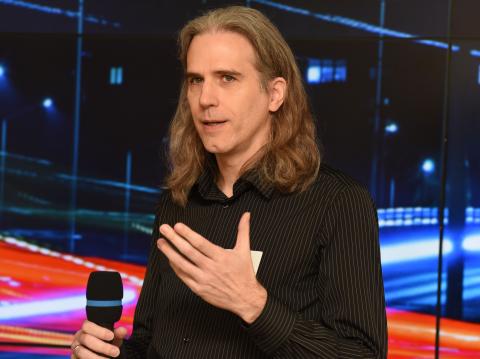On Friday, October 18, 2024, the School of Computing and Informatics (CMIX) hosted the Science Day event.
VR Lab Shows Intercontinental Networked VR and Receives Related Grants
Mon, 01/08/2018 - 11:31pmDr. Christoph Borst and Ph.D. student Nicholas Lipari demonstrated live networked VR connecting UL Lafayette to an auditorium nearly 10,000 miles away at the University of South Australia. VR users in Adelaide, Australia saw Nicholas standing before them, virtually, based on livestreamed 3D camera imagery from Lafayette. The event launched a new gigabit initiative that creates a global partnership of Smart Gigabit Communities.


Dr. Borst also received new grants for networked VR from Mozilla's Gigabit Community fund and from the US Ignite Developers Fund. The Mozilla project is evaluating educational aspects of livestreamed teachers in VR and is also guiding high school students to create their own VR environments. The US Ignite project supports further technological developments and testing with high-performance intercity networks.
The networked VR framework, "Kvasir-VR", started as a system for remotely-guided geosciences exploration, connecting a geologist in Dr. Borst’s lab to a VR audience at LITE, Louisiana’s large-scale 3D visualization facility. An NSF project to extend this work applied the concepts to energy plant field trips, in collaboration with Mechanical Engineering faculty. Kvasir-VR previously received a 2016 demo award from US Ignite and a "Best Research Demo" award from the 2017 IEEE VR conference.
The data streaming from Lafayette to Australia traversed several high-performance networks. The VR Lab connected to LONI (Louisiana Optical Network), which in turn connected to Internet2 to send data through Texas, Arizona, and California. From there, Pacific Wave connected to Seattle and Honolulu, then to the Australian Academic Research Network.
More information can be found at the links below:
- Event Press Release: https://www.us-ignite.org/news/us-ignite-smart-gigabit-communities-adelaide-australia-and-lafayette-louisiana-announce-partnership-to-bring-advanced-virtual-reality-application-to-australia/
- US Ignite Project Summary: https://www.us-ignite.org/apps/remotely-guided-vr-field-trips-with-kvasir-vr-and/
- Mozilla Project Summary: https://www.mozillapulse.org/entry/557
